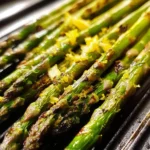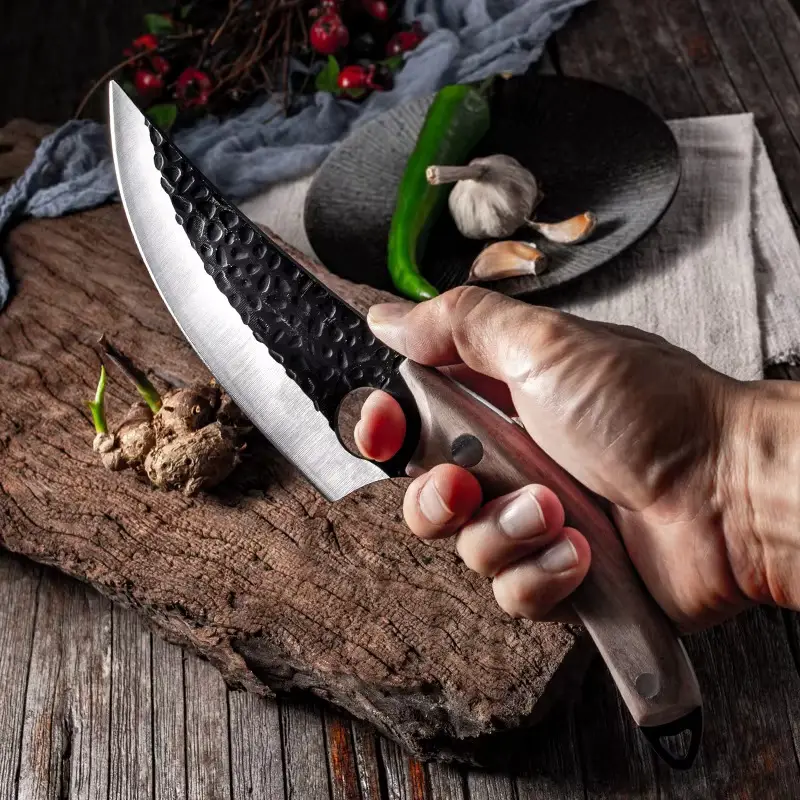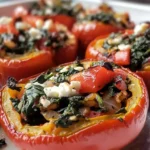Grilled Asparagus with Lemon Zest is a dish that has quickly become a staple in our household, especially during the warmer months. There’s something truly magical about the way the smoky char of the grill perfectly complements the bright, zesty flavor of lemon on tender asparagus spears. Even my kids, who are usually a bit hesitant when it comes to green vegetables, devour this dish without a second thought. It’s incredibly simple to make, yet it feels elegant enough to serve at a dinner party. Whether we’re having a casual BBQ or a more formal family meal, grilled asparagus with lemon zest is always a welcome addition to the table. Its vibrant flavor and ease of preparation make it a winner in my book, and I’m excited to share this recipe with you, hoping it becomes a favorite in your home too!
Ingredients
- Fresh Asparagus: One pound, look for firm, bright green spears with tightly closed tips.
- Olive Oil: Two tablespoons, extra virgin olive oil is recommended for its flavor and health benefits.
- Lemon: One medium-sized lemon, for both zest and juice. Choose a lemon that feels heavy for its size, indicating it is juicy.
- Salt: To taste, kosher salt or sea salt enhances the flavors of the asparagus and lemon.
- Black Pepper: Freshly ground, to taste, adds a subtle spice and depth of flavor.
Instructions
- Prepare the Asparagus: Begin by washing the asparagus thoroughly under cold running water. Pat them dry with a clean kitchen towel or paper towels. This step is crucial because excess water can hinder the grilling process and lead to steaming instead of charring. Next, trim the woody ends of the asparagus spears. To do this easily, hold a spear near the base and bend it gently – it will naturally snap at the point where the tender part begins and the woody end starts. Alternatively, you can line up the asparagus spears and cut off about an inch or two from the bottom ends. Discard the woody ends.
- Zest and Juice the Lemon: Using a microplane or a fine grater, zest the lemon. Make sure to only grate the yellow part of the peel, avoiding the white pith underneath, as it can be bitter. You’ll need about one teaspoon of lemon zest for this recipe. Set the zest aside. Then, cut the lemon in half and juice it using a citrus juicer or by hand. You’ll need about one tablespoon of fresh lemon juice. Set the juice aside as well. The lemon zest brings a bright, aromatic citrus oil to the dish, while the juice adds a tangy acidity that balances the richness of the olive oil and the slight bitterness of the grilled asparagus.
- Season the Asparagus: In a medium-sized bowl, place the trimmed asparagus spears. Drizzle them with two tablespoons of olive oil. Using your hands or tongs, toss the asparagus to ensure they are evenly coated with the oil. This is important because the olive oil not only adds flavor but also prevents the asparagus from sticking to the grill grates and helps them to char beautifully. After the asparagus is coated in oil, season generously with salt and freshly ground black pepper. Again, toss to distribute the seasoning evenly. Don’t be shy with the seasoning – it’s crucial for bringing out the best flavors in the asparagus.
- Preheat the Grill: Preheat your grill to medium-high heat. For a gas grill, this usually means setting the burners to medium-high and allowing it to preheat for about 5-10 minutes until the grates are hot. For a charcoal grill, light the charcoal and wait until it’s covered in a white-gray ash and the grill is hot. A hot grill is essential for achieving those beautiful grill marks and the slightly smoky, tender-crisp texture that makes grilled asparagus so delicious. If you don’t have a grill, you can also use a grill pan on your stovetop, or even roast the asparagus in the oven at 400°F (200°C) for about 10-15 minutes, though the flavor will be slightly different without the smoky char.
- Grill the Asparagus: Once the grill is hot, carefully place the asparagus spears directly onto the grill grates in a single layer. Make sure they are not overcrowded, as overcrowding can lead to steaming instead of grilling. If necessary, grill in batches. Grill the asparagus for about 5-7 minutes, turning them occasionally using tongs, until they are tender-crisp and have grill marks on all sides. The exact grilling time will depend on the thickness of your asparagus and the heat of your grill, so keep a close eye on them. You want them to be cooked through but still have a bit of bite – they should not be mushy. The goal is to achieve a balance between tender interiors and slightly charred exteriors.
- Add Lemon Zest and Juice: Remove the grilled asparagus from the grill and transfer them to a serving platter or a clean bowl. Immediately sprinkle the reserved lemon zest evenly over the hot asparagus. The heat from the asparagus will help to release the aromatic oils from the zest, enhancing the lemon flavor. Then, drizzle the fresh lemon juice over the asparagus. Toss gently to ensure the zest and juice are distributed. The combination of the warm, grilled asparagus, bright lemon zest, and tangy lemon juice is what makes this dish so refreshing and flavorful.
- Serve Immediately: Grilled asparagus with lemon zest is best served immediately while it’s still warm and the asparagus is tender-crisp. This dish is perfect as a side dish for grilled meats, fish, chicken, or vegetarian mains. It also works beautifully as part of a larger salad or as an appetizer. Garnish with extra lemon wedges if desired, and perhaps a sprinkle of flaky sea salt or red pepper flakes for an extra touch of flavor and visual appeal. Enjoy the delightful combination of smoky, lemony, and fresh flavors!
Nutrition Facts
Serving Size: Approximately 1/4 of the recipe
Calories per Serving: Approximately 80 kcal
- Fat: 7g
- Saturated Fat: 1g
- Sodium: 150mg (values can vary based on salt added)
- Vitamin C: 15% DV (Daily Value)
(Note: Nutritional values are estimates and can vary based on specific ingredients and portion sizes.)
Preparation Time
Prep Time: 10 minutes. This includes washing and trimming the asparagus, zesting and juicing the lemon, and tossing the asparagus with olive oil and seasonings. It’s quick and straightforward, perfect for busy weeknights or when you need a fast yet flavorful side dish.
Cook Time: 5-7 minutes. Grilling asparagus is remarkably fast, especially on a hot grill. This short cooking time ensures the asparagus retains its vibrant green color and tender-crisp texture without becoming overcooked and mushy. The entire process from start to finish is under 20 minutes, making it an ideal choice for a last-minute side dish that doesn’t compromise on flavor or nutrition.
How to Serve Grilled Asparagus with Lemon Zest
Grilled Asparagus with Lemon Zest is incredibly versatile and pairs wonderfully with a wide variety of dishes. Here are some serving suggestions:
- As a Side Dish for Grilled Mains:
- Grilled Chicken or Fish: The bright, lemony flavor of the asparagus cuts through the richness of grilled chicken or fatty fish like salmon or tuna, creating a balanced and delicious meal.
- Steaks or Burgers: Asparagus provides a healthy and flavorful vegetable complement to heavier grilled meats like steak or burgers, adding freshness and lightness to the plate.
- Vegetarian Grill Options: Serve alongside grilled halloumi, portobello mushrooms, or veggie burgers for a complete and satisfying vegetarian or vegan meal.
- In Salads:
- Warm Asparagus Salad: Toss grilled asparagus with mixed greens, cherry tomatoes, crumbled feta cheese (or vegan feta), and a light vinaigrette for a warm and flavorful salad.
- Asparagus and Grain Salad: Combine grilled asparagus with cooked quinoa, farro, or couscous, along with roasted red peppers, olives, and a lemon-herb dressing for a hearty and nutritious salad.
- Asparagus and Egg Salad: Top a bed of mixed greens with grilled asparagus, hard-boiled or poached eggs, and a Dijon vinaigrette for a protein-rich and vibrant salad.
- As an Appetizer or Part of a Charcuterie Board:
- Grilled Asparagus Platter: Arrange grilled asparagus on a platter with lemon wedges, shaved Parmesan cheese (or vegan Parmesan), and a drizzle of balsamic glaze for an elegant appetizer.
- Charcuterie Board Addition: Include grilled asparagus on a charcuterie board alongside cheeses, cured meats, olives, and crusty bread for a fresh and colorful element.
- With Pasta or Risotto:
- Asparagus Pasta: Chop grilled asparagus and toss it with pasta, lemon zest, Parmesan cheese, and a touch of cream or olive oil for a simple yet flavorful pasta dish.
- Asparagus Risotto: Stir grilled asparagus into a creamy risotto during the last few minutes of cooking for added texture and flavor.
- Alongside Eggs for Breakfast or Brunch:
- Asparagus and Eggs: Serve grilled asparagus alongside scrambled eggs, omelets, or frittatas for a healthy and delicious breakfast or brunch option.
- Eggs Benedict with Asparagus: Replace traditional ham or bacon with grilled asparagus in Eggs Benedict for a lighter and vegetarian-friendly twist.
Additional Tips for Perfect Grilled Asparagus with Lemon Zest
- Choose Asparagus of Similar Thickness: When selecting asparagus, try to choose spears that are roughly the same thickness. This ensures that they will cook evenly on the grill. Thicker spears will take longer to cook than thinner ones, so a uniform thickness helps prevent some spears from being overcooked while others are still undercooked. If you have a mix of thick and thin spears, you can grill the thicker ones for a minute or two longer before adding the thinner ones.
- Don’t Overcrowd the Grill: Avoid overcrowding the grill grates when grilling asparagus. Overcrowding can lower the temperature of the grill and cause the asparagus to steam instead of char, resulting in a less desirable texture. Grill in batches if necessary to ensure each spear has enough space to cook properly and develop those lovely grill marks. Spacing allows for better heat circulation and ensures even cooking and charring.
- Use a Grill Basket or Grill Pan for Thinner Spears: If you are grilling very thin asparagus spears, they may fall through the grill grates. To prevent this, use a grill basket or a grill pan. These tools provide a solid surface for grilling delicate vegetables and prevent them from slipping through the cracks. They also make it easier to flip and manage the asparagus while grilling.
- Preheat the Grill Properly: Ensure your grill is properly preheated to medium-high heat before adding the asparagus. A hot grill is crucial for searing the asparagus quickly and creating those desirable grill marks. Preheat the grill for at least 5-10 minutes to allow the grates to get hot enough. You should be able to hear a sizzle when you place a drop of water on the grates.
- Control the Heat and Don’t Overcook: Asparagus cooks relatively quickly on the grill. Keep a close eye on it and don’t overcook it. Overcooked asparagus will become mushy and lose its vibrant green color. Aim for tender-crisp asparagus that still has a bit of bite. Grilling for 5-7 minutes is usually sufficient, but the exact time will depend on the thickness of the spears and the heat of your grill.
- Experiment with Marinades (Optional): While simple olive oil, salt, and pepper are often enough, you can experiment with marinades to add extra flavor to your grilled asparagus. Try marinating the asparagus for 15-30 minutes before grilling in a mixture of olive oil, balsamic vinegar, garlic, herbs like thyme or rosemary, or a touch of Dijon mustard. Marinades can infuse the asparagus with deeper flavors and add complexity to the dish.
- Add Other Seasonings and Spices: Lemon zest is the star in this recipe, but you can enhance the flavor further by adding other seasonings and spices. Consider incorporating a pinch of red pepper flakes for a touch of heat, garlic powder or minced garlic for a savory note, or herbs like fresh thyme, oregano, or parsley for an herbaceous aroma. Experiment with different combinations to find your favorite flavor profile.
- Finish with Flaky Sea Salt and Extra Lemon: For a final touch of flavor and texture, sprinkle the grilled asparagus with flaky sea salt just before serving. The large crystals of flaky sea salt provide a pleasant crunch and a burst of salty flavor. Serving with extra lemon wedges on the side allows people to add more lemon juice to taste, enhancing the bright and zesty notes of the dish. This finishing touch elevates the simple grilled asparagus to a more gourmet level.
Frequently Asked Questions (FAQ) About Grilled Asparagus with Lemon Zest
Q1: Can I grill asparagus ahead of time and reheat it?
A: While grilled asparagus is best served immediately for optimal texture, you can grill it a few hours in advance and reheat it gently. To reheat, lightly drizzle with olive oil and warm it in a 350°F (175°C) oven for about 5-10 minutes, or briefly on a grill pan over low heat. Reheating may slightly soften the asparagus, so it’s best to enjoy it fresh if possible.
Q2: What if I don’t have a grill? Can I cook asparagus another way?
A: Yes, absolutely! If you don’t have a grill, you can roast asparagus in the oven. Preheat your oven to 400°F (200°C). Toss the asparagus with olive oil, salt, and pepper, and spread them in a single layer on a baking sheet. Roast for 10-15 minutes, or until tender-crisp. You can also use a grill pan on your stovetop to achieve a slightly smoky flavor.
Q3: How do I prevent asparagus from becoming mushy when grilled?
A: To prevent mushy asparagus, ensure your grill is hot and don’t overcook it. Grill for only 5-7 minutes, or until tender-crisp. Overcrowding the grill can also lead to steaming instead of grilling, so grill in batches if necessary. Choosing asparagus spears of similar thickness will also help ensure even cooking.
Q4: Can I use bottled lemon juice instead of fresh lemon juice?
A: Fresh lemon juice is always preferred for its brighter and more vibrant flavor. However, if you don’t have fresh lemons, you can use bottled lemon juice as a substitute. Use about 1 tablespoon of bottled lemon juice, but keep in mind that the flavor might not be as zesty and fresh as with freshly squeezed juice.
Q5: What are some variations I can try with this recipe?
A: There are many variations you can try! You can add grated Parmesan cheese (or vegan Parmesan) after grilling, sprinkle with toasted pine nuts or slivered almonds for crunch, drizzle with balsamic glaze for sweetness, or add a pinch of red pepper flakes for heat. You can also experiment with different herbs like thyme, rosemary, or oregano.
Q6: Is grilled asparagus with lemon zest healthy?
A: Yes, grilled asparagus with lemon zest is a very healthy dish. Asparagus is low in calories and fat, and a good source of vitamins K, A, and C, as well as folate and fiber. Olive oil provides healthy fats, and lemon zest and juice add vitamin C and antioxidants. Grilling is also a healthy cooking method as it requires minimal added fat.
Q7: Can I marinate the asparagus before grilling?
A: Yes, marinating asparagus before grilling can add extra flavor. You can marinate it for 15-30 minutes in a mixture of olive oil, balsamic vinegar, garlic, herbs, or Dijon mustard. Be careful not to marinate for too long in acidic marinades as it can make the asparagus mushy.
Q8: What dishes pair well with grilled asparagus with lemon zest?
A: Grilled asparagus with lemon zest pairs well with a wide variety of dishes. It’s a fantastic side dish for grilled chicken, fish, steak, or vegetarian mains like halloumi or portobello mushrooms. It also works beautifully in salads, pasta dishes, risottos, and alongside eggs for breakfast or brunch. Its bright and fresh flavor makes it a versatile accompaniment to many meals.

Grilled Asparagus with Lemon Zest
Ingredients
- Fresh Asparagus: One pound, look for firm, bright green spears with tightly closed tips.
- Olive Oil: Two tablespoons, extra virgin olive oil is recommended for its flavor and health benefits.
- Lemon: One medium-sized lemon, for both zest and juice. Choose a lemon that feels heavy for its size, indicating it is juicy.
- Salt: To taste, kosher salt or sea salt enhances the flavors of the asparagus and lemon.
- Black Pepper: Freshly ground, to taste, adds a subtle spice and depth of flavor.
Instructions
- Prepare the Asparagus: Begin by washing the asparagus thoroughly under cold running water. Pat them dry with a clean kitchen towel or paper towels. This step is crucial because excess water can hinder the grilling process and lead to steaming instead of charring. Next, trim the woody ends of the asparagus spears. To do this easily, hold a spear near the base and bend it gently – it will naturally snap at the point where the tender part begins and the woody end starts. Alternatively, you can line up the asparagus spears and cut off about an inch or two from the bottom ends. Discard the woody ends.
- Zest and Juice the Lemon: Using a microplane or a fine grater, zest the lemon. Make sure to only grate the yellow part of the peel, avoiding the white pith underneath, as it can be bitter. You’ll need about one teaspoon of lemon zest for this recipe. Set the zest aside. Then, cut the lemon in half and juice it using a citrus juicer or by hand. You’ll need about one tablespoon of fresh lemon juice. Set the juice aside as well. The lemon zest brings a bright, aromatic citrus oil to the dish, while the juice adds a tangy acidity that balances the richness of the olive oil and the slight bitterness of the grilled asparagus.
- Season the Asparagus: In a medium-sized bowl, place the trimmed asparagus spears. Drizzle them with two tablespoons of olive oil. Using your hands or tongs, toss the asparagus to ensure they are evenly coated with the oil. This is important because the olive oil not only adds flavor but also prevents the asparagus from sticking to the grill grates and helps them to char beautifully. After the asparagus is coated in oil, season generously with salt and freshly ground black pepper. Again, toss to distribute the seasoning evenly. Don’t be shy with the seasoning – it’s crucial for bringing out the best flavors in the asparagus.
- Preheat the Grill: Preheat your grill to medium-high heat. For a gas grill, this usually means setting the burners to medium-high and allowing it to preheat for about 5-10 minutes until the grates are hot. For a charcoal grill, light the charcoal and wait until it’s covered in a white-gray ash and the grill is hot. A hot grill is essential for achieving those beautiful grill marks and the slightly smoky, tender-crisp texture that makes grilled asparagus so delicious. If you don’t have a grill, you can also use a grill pan on your stovetop, or even roast the asparagus in the oven at 400°F (200°C) for about 10-15 minutes, though the flavor will be slightly different without the smoky char.
- Grill the Asparagus: Once the grill is hot, carefully place the asparagus spears directly onto the grill grates in a single layer. Make sure they are not overcrowded, as overcrowding can lead to steaming instead of grilling. If necessary, grill in batches. Grill the asparagus for about 5-7 minutes, turning them occasionally using tongs, until they are tender-crisp and have grill marks on all sides. The exact grilling time will depend on the thickness of your asparagus and the heat of your grill, so keep a close eye on them. You want them to be cooked through but still have a bit of bite – they should not be mushy. The goal is to achieve a balance between tender interiors and slightly charred exteriors.
- Add Lemon Zest and Juice: Remove the grilled asparagus from the grill and transfer them to a serving platter or a clean bowl. Immediately sprinkle the reserved lemon zest evenly over the hot asparagus. The heat from the asparagus will help to release the aromatic oils from the zest, enhancing the lemon flavor. Then, drizzle the fresh lemon juice over the asparagus. Toss gently to ensure the zest and juice are distributed. The combination of the warm, grilled asparagus, bright lemon zest, and tangy lemon juice is what makes this dish so refreshing and flavorful.
- Serve Immediately: Grilled asparagus with lemon zest is best served immediately while it’s still warm and the asparagus is tender-crisp. This dish is perfect as a side dish for grilled meats, fish, chicken, or vegetarian mains. It also works beautifully as part of a larger salad or as an appetizer. Garnish with extra lemon wedges if desired, and perhaps a sprinkle of flaky sea salt or red pepper flakes for an extra touch of flavor and visual appeal. Enjoy the delightful combination of smoky, lemony, and fresh flavors!
Nutrition
- Serving Size: one normal portion
- Calories: 80
- Fat: 7g
- Saturated Fat: 1g






